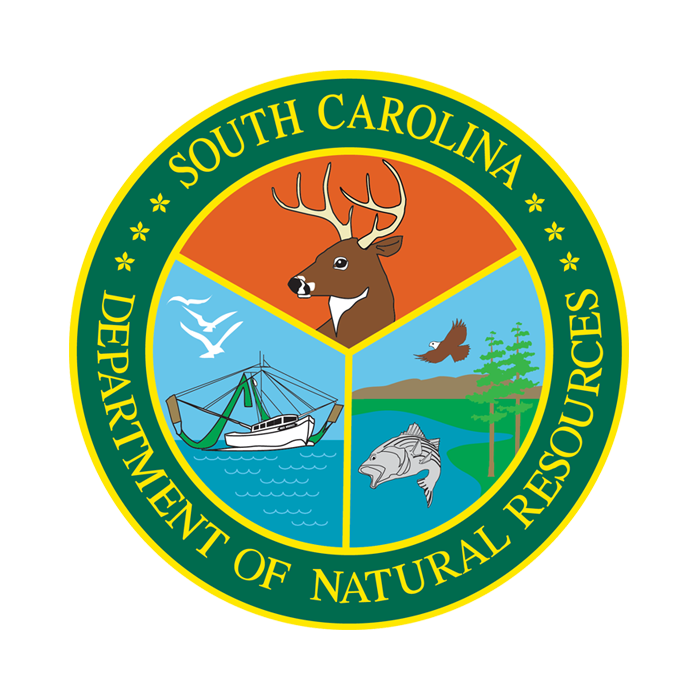Threats & Protection
Coastal Development
Southeastern coastlines are alluring places for millions of residents and visitors. In fact, over 50% of the U.S. population lives in coastal zones throughout the country. The scenic views and natural beauty of the salt marsh-tidal creek ecosystem are major factors attracting people to our coasts. As the country’s population continues to grow, it becomes increasingly important to take actions to protect the salt marsh-tidal creek ecosystem for enjoyment and use by current and future generations.

Development along a marsh
Coastal development in the Southeast is occurring in a manner that is consuming forests at a rate many times faster than the human population is growing. This pattern of development, called urban sprawl, creates communities with large amounts of paved areas, such as roads, parking lots and roofs.
These impervious surfaces prevent rainfall from filtering slowly into soils, and instead flush it quickly into marshes and tidal creeks. This stormwater runoff, called non-point source pollution, contains nutrients, chemicals like gasoline and oil, pathogens like fecal bacteria, and sediments. This pollution has the potential to cause harm to our salt marshes and tidal creeks.
Watersheds with greater than 10% impervious surface levels have increased chemicals, nutrients, and fecal bacteria in tidal creeks. Tidal creek biotic health is impaired when the amount of impervious surface within a watershed exceeds 20-30%. We can minimize these impacts by taking simple steps to reduce the amount of impervious surface and pollution. Communities are starting to encourage low impact development best management practices like pervious concrete and upland vegetative buffers that filter larger amounts of runoff through soils and vegetation to sequester pollutants. Public education programs have been initiated to help reduce the chemicals, nutrients and pathogens entering our salt marsh and tidal creek systems.
Fishing
Commercial and recreational fisheries provide significant economic benefits to the Southeast region and to our quality of life. Most of the harvested species depend on the salt marsh-tidal creek ecosystem as a nursery and refuge from predators. Increased fishing pressures have the potential to reduce the population of commercially and recreationally important species faster than they can reproduce. The capture of non-target organisms, called by-catch, during recreational and commercial fishing activities can have indirect impacts as well. For example, the diamondback terrapin often enters crab traps, and if kept underwater for too long, these turtles will drown. Resource management agencies carefully monitor harvests, by-catch, and populations levels, and use this information to establish fishing limits and regulations. Fishing restrictions, practicing catch and release, and new by-catch reducing technologies, such as terrapin excluder devices, enable us to conserve our marine resources.
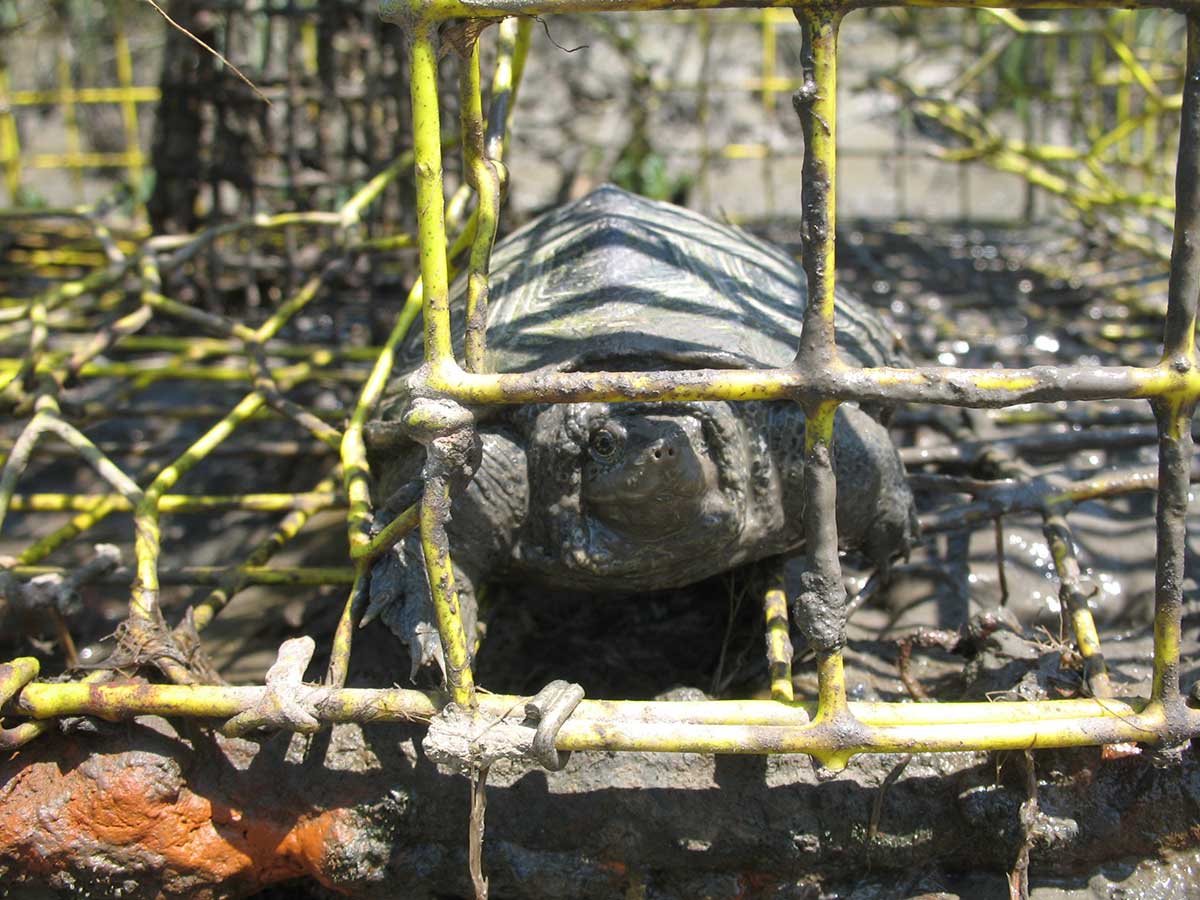
Diamondback terrapin in a crab trap
Invasive Species
Invasive species are plants or animals that are not naturally found in a location and which aggressively spread when introduced into new habitats.
Accidental and intentional introductions of invasive species are frequently a threat to native organisms. They compete with native species for resources and may expose them to new pathogens and disease, often resulting in the invasive species taking over an ecological role, or niche, of a native organism.
Non-native species are being introduced all the time through ocean currents, ballast water, and as hitchhikers on boats and animals. Fortunately, few organisms have the adaptations that allow them to sustain their populations in the salt marsh-tidal creek ecosystem, and very few invasive species are found there. Several invasive species that do occur include the tiger shrimp, the macroalgae Gracilaria, and the reed Phragmites. As new invasive species are introduced, precise tracking of their status and distribution is imperative; however, it can be very difficult to achieve.
Tiger Shrimp
Tiger shrimp, Penaeus monodon, are a large shrimp (up to 12 inches, 30cm; 1 pound, 453g) with black stripes. Tiger shrimp are native to the Indo-Pacific, Asian, and Australian waters. While the exact method of their introduction is unknown, it is thought that they entered Southeastern waters by ballast water, movement by current transport and/or releases from an aquaculture facility.
Adult tiger shrimp tend to be much larger than their native counterparts and may prey on them. They are also thought to compete with native shrimp for food and habitat resources. Sightings of tiger shrimp in the Southeast are increasing. Biologists are continuing to track the tiger shrimp’s introduction by asking recreational and commercial shrimpers to report the location and frequency of any tiger shrimp caught in their nets.
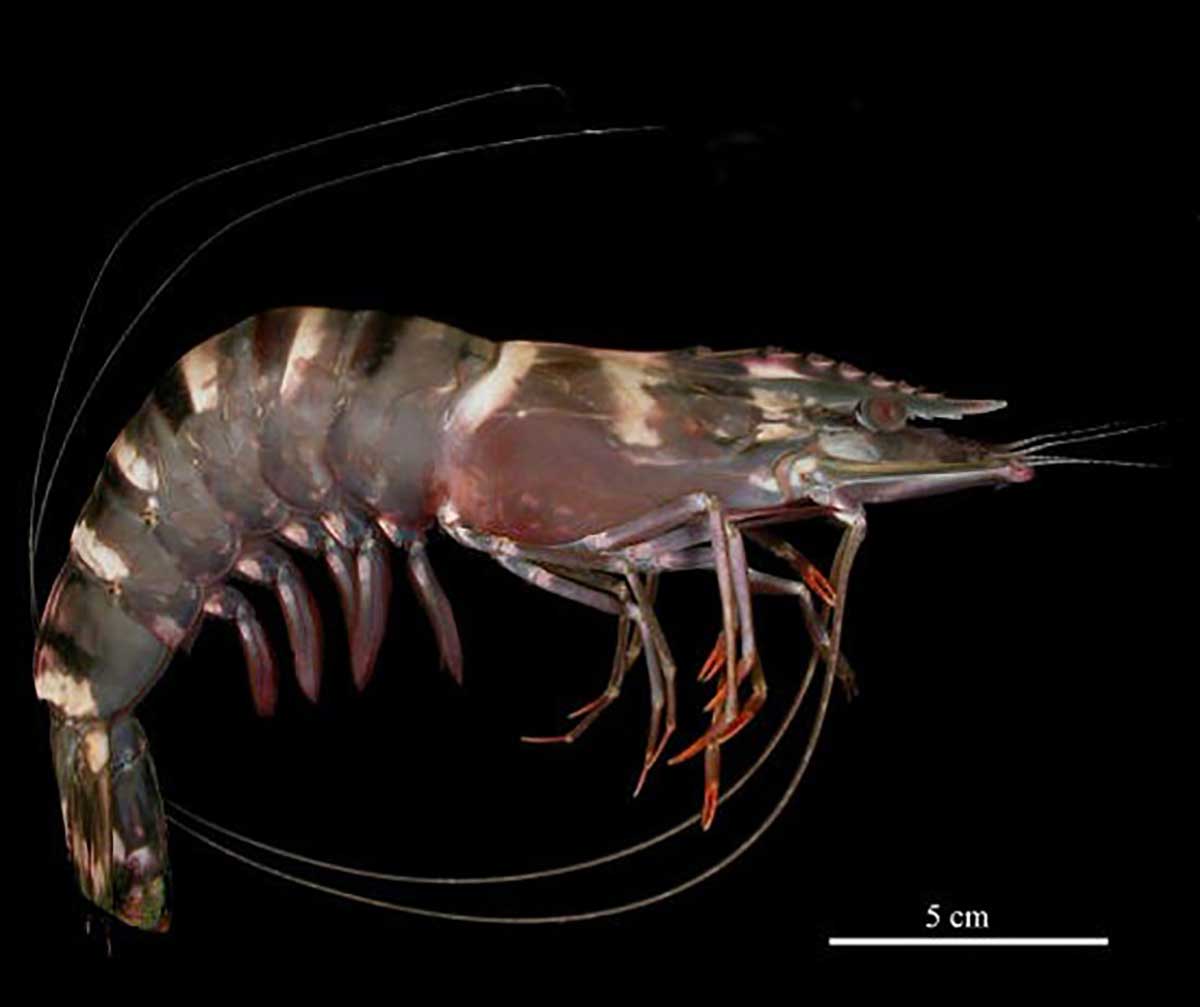
Penaeus monodon
Gracilaria
Gracilaria vermiculophylla is a branched red macroalgae, approximately eight inches (20cm) long and was originally native to Asia. In Asia, it is cultured for use in food products such as ice cream and jelly.
The invasion of Gracilaria into the Southeast has occurred relatively recently and may have resulted from ballast water, hull fouling, or Pacific oyster imports. Gracilaria has invaded mud flats that have historically not had significant amounts of algae. It has changed the mud flat habitat by providing vertical structure where none was before, altering species compositions and oyster growth.
Depending on the animal, it can have positive and negative effects. How this species will alter the salt marsh and tidal creek ecosystem in the future is unknown. Trawl nets have been known to become clogged with Gracilaria, impacting shrimp fisheries. You will most likely see Gracilaria washed up on land, covering a mud flat, or caught in your nets.
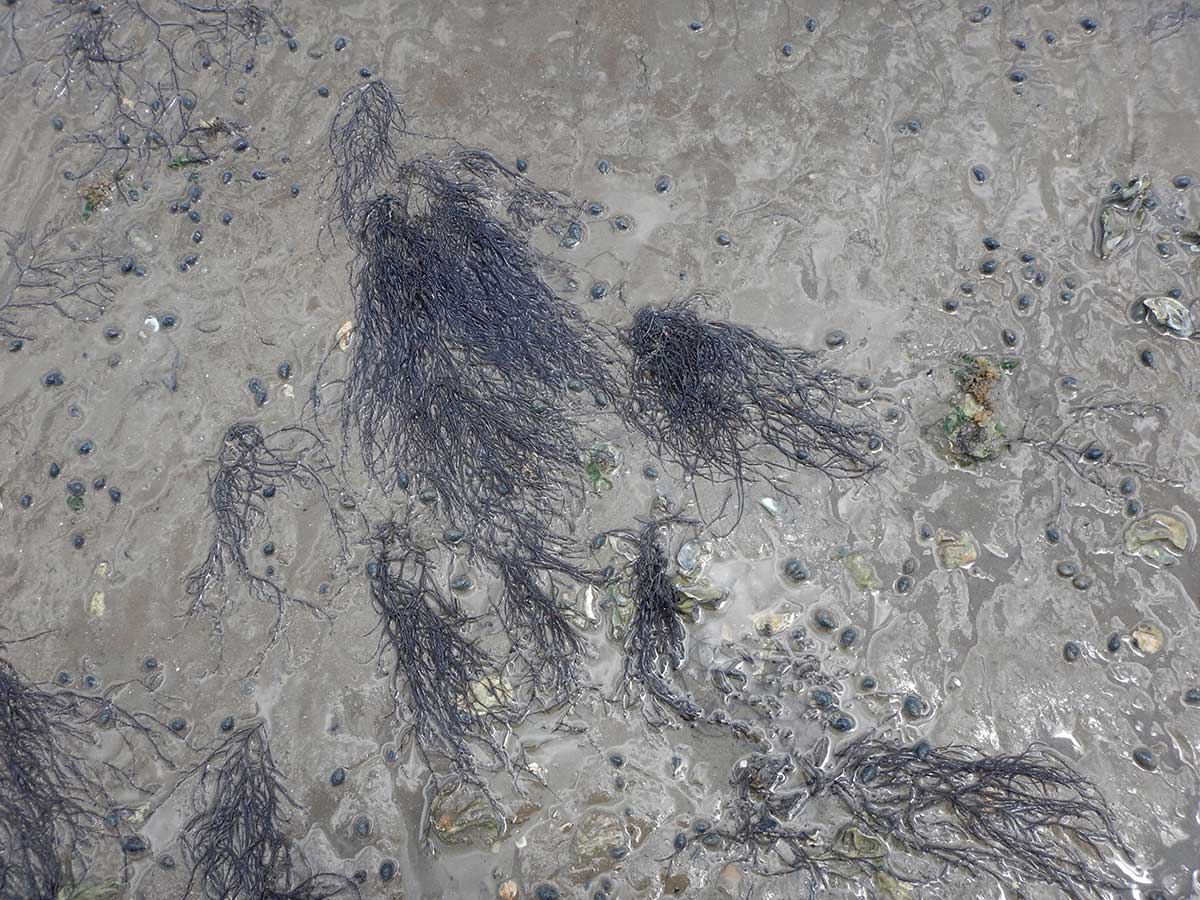
Gracilaria vermiculophylla
Phragmites
Phragmites australis is a tall reed which can reach heights of ten to twelve feet (3-3.5m) and can occur in less saline areas.
Three separate sub-species of Phragmites australis occur in the U.S., two are native and one is an invasive sub-species from Europe dating back to the 1700s or 1800s. The invasive sub-species was likely introduced to the region through ballast water. The sub-species are very hard to tell apart and often require DNA testing to distinguish them. The invasive sub-species is more common on disturbed habitats such as developed shorelines and forms denser stands than the native species.
Seeds of Phragmites can be spread by the wind, but an individual plant can also spread by rhizomes, similar to Spartina. The tall height of Phragmites can shade out shorter native plants, and the dense stands decrease the quality of salt marsh habitat, effectively altering the natural function of the salt marsh-tidal creek ecosystem. Many states have programs to control the spread of Phragmites, but it is a constant battle.
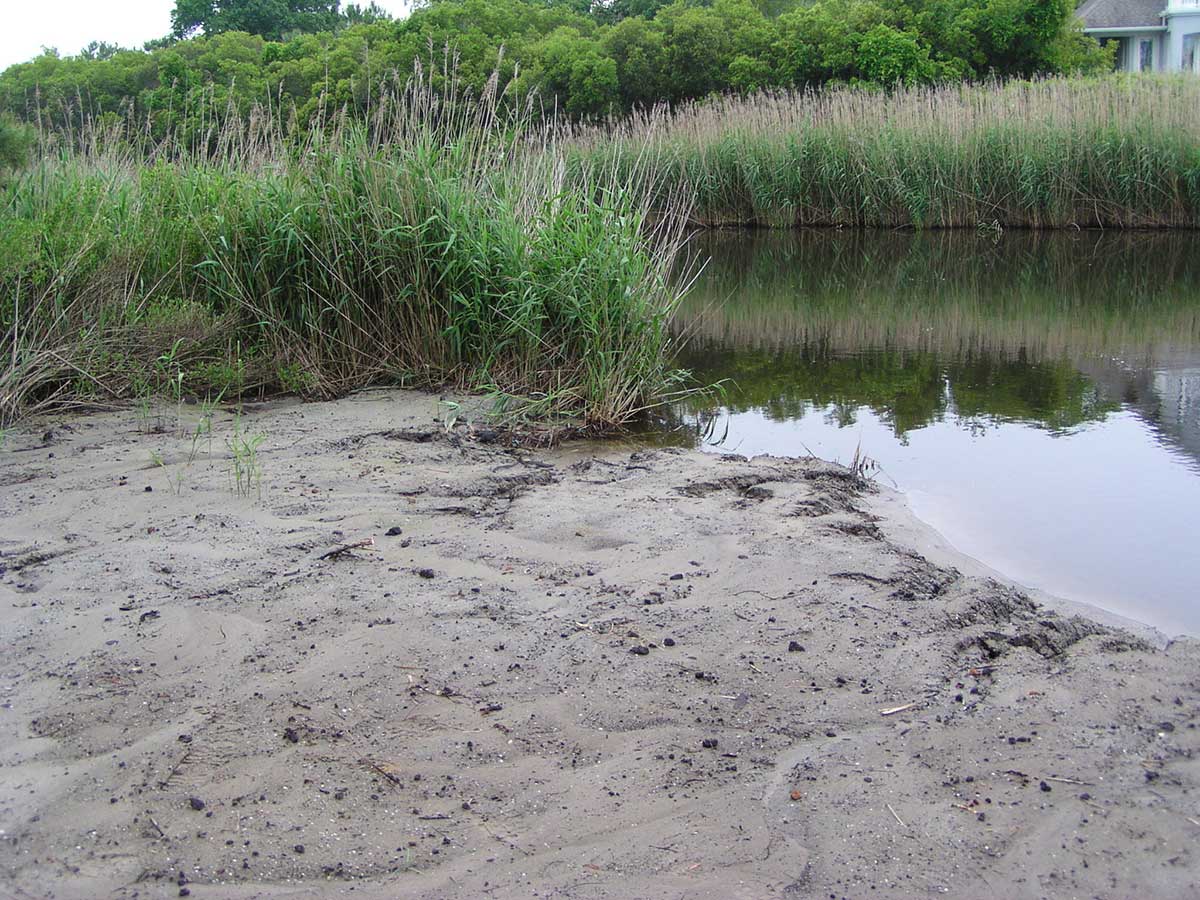
Phragmites australis
Climate Change and Sea-Level Rise

Spartina trapping sediment
Salt marshes and tidal creeks are vulnerable to the changing climate and sea-level rise.
When excess carbon dioxide is released into the atmosphere from burning fossil fuels such as coal, oil, and gas, it acts like a heat trapping blanket and causes the atmosphere to warm. This leads to polar ice caps melting and the ocean water warming and expanding, which causes sea level to rise. An increase of a few inches in sea level can result in major changes in plant and animal distribution in the marsh.
For the salt marsh platform to survive, the sediment accumulation on the marsh surface and Spartina growth must occur at the same pace or faster than the rising sea level. If the marsh surface cannot keep pace, Spartina and other marsh plants will drown. The salt marsh will then become open water muddy habitat, with greater potential of erosion.
Vegetative buffers on the uplands adjacent to salt marshes can reduce the risk by allowing the salt marsh to migrate back as the sea level rises. In addition, increasing temperature would increase evaporation, which could lead to increased salinity levels in the sediment. Creating open water habitat or increasing sediment salinity levels will change which plant and animal species live in the marsh. We largely do not know what all of the effects will be; however, the salt marsh-tidal creek food web for all life in the marsh, including people, will likely change with a changing climate.
Protection and Legislation
Since the 18th century, people have ”reclaimed” acres of salt marsh and tidal creek habitat by filling them in with refuse and soil to create dry uplands for agriculture, houses, and other forms of development.
Historically, the marsh platform was used as grazing areas for cows. In addition, much of historic Charleston, S.C., was filled in during the late 1700s and early 1800s, creating notable downtown areas like the City Market. This practice continued into the 20th century, with little realization of the extent of impact filling salt marshes and tidal creeks has on natural drainage patterns, thus leaving the coastline in a heightened state of vulnerability, particularly during storm events.
In the 1970s, in an effort to regulate future impacts on marshes, Federal and State governments began to develop and implement legislation to protect the remaining coastal wetlands. For the first time, legislation regulated activities that could occur on or in the salt marsh-tidal creek ecosystem. Permits are now required before any new activity can occur. Pieces of legislation identified areas of environmental concern in each state, and developed management strategies that balance use and preservation of the coastal habitat, and regulate the kind of activities allowed on coastal wetlands with the ultimate goal of protecting the salt marsh-tidal creek ecosystem.
In 1970, Georgia was the first state to establish coastal wetlands legislation. The Coastal Marshlands Protection Act was developed through the Georgia Department of Natural Resources. The Act led the way for the rest of the Southeast. After the National Coastal Zone Management Act was authorized in 1972, North Carolina established the Coastal Area Management Act of 1974, which is managed by the North Carolina Department of Environment and Natural Resources. In 1977, South Carolina implemented the Coastal Tidelands and Wetlands Act, which is managed by the SC Department of Health and Environmental Control. In 1978, the Florida Coastal Zone Management Act was implemented by the Florida Department of Environmental Program. This last Act rounded out the legislative protection of Southeast marshes and tidal creeks.

